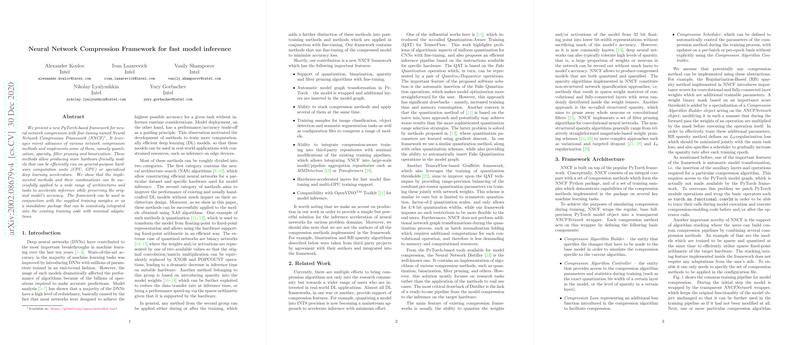Neural Network Compression Framework for Fast Model Inference
This paper introduces the Neural Network Compression Framework (NNCF), a PyTorch-based tool engineered to enhance neural network efficiency through various compression techniques. With the escalated computational requirements of deep neural networks (DNNs), this framework seeks to facilitate faster model inferences, particularly on resource-constrained hardware, by implementing quantization, sparsity, filter pruning, and binarization.
Framework Features
The authors highlight several key features of NNCF:
- Quantization: Both symmetric and asymmetric quantization schemes are supported, with optional mixed-precision strategies. The framework enables automatic fake quantization insertion into the model graph, aiding the preservation of accuracy while optimizing model performance.
- Binarization: Binarization of weights and activations is supported, leveraging techniques like XNOR and DoReFa, achieving a significant reduction in model complexity albeit with some accuracy trade-offs.
- Sparsity and Pruning: Methods for both magnitude-based and regularization-based sparsification are implemented, capable of preserving accuracy while reducing network complexity. Filter pruning is also integrated, allowing the removal of less salient filters to streamline model execution.
- Model Transformation and Stacking: NNCF performs automatic model transformation by inserting compression layers and supports stacking of multiple compression methods to achieve compounded benefits.
Numerical Results and Claims
Strong numerical results were presented across diverse model types and use cases, including image classification, object detection, and natural language processing:
- INT8 quantization achieved up to 3.11x speed improvements with negligible accuracy drops across well-known models like ResNet50 and MobileNet variations.
- Mixed-precision quantization showed promise in preserving accuracy within 1% of full precision, indicating a viable pathway for applications demanding extreme inference efficiency.
- When combining sparsity and quantization, the framework consistently produced models with competitive accuracy while enhancing runtime efficiency.
Practical Implications
The practical implications of this work are significant in domains where reduced model latency and size directly contribute to better system performance, such as in mobile or embedded devices. By integrating seamlessly with existing PyTorch codebases and supporting export to ONNX for subsequent inference via OpenVINO, NNCF provides a comprehensive solution for deploying compressed models in real-world applications.
Theoretical Implications
On a theoretical level, the amalgamation of several compression techniques and the capacity to stack these within a single framework may inspire new research directions investigating the interplay and optimal configuration of different compression strategies. Additionally, the alignment of compression methodologies with hardware-specific capabilities (e.g., fixed-point arithmetic) raises important considerations for architecture design and optimization.
Future Directions
Future expansions of NNCF might include refining algorithms for ultra-low precision quantization, extending model compatibility, or incorporating real-time learning schemes adaptive to dynamically changing hardware conditions. Furthermore, as AI models become more pervasive, exploring automated or AI-driven compression strategy selection could enhance usability and model deployment effectiveness further.
In conclusion, the NNCF framework presents a robust toolset for neural network compression, effectively balancing performance gains with accuracy maintenance, therefore marking an essential resource for researchers and practitioners aiming to optimize DNN inference.
